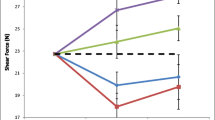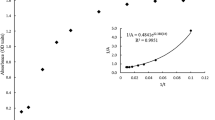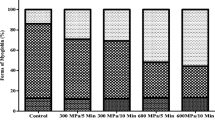Abstract
The effects of papain and high-pressure processing (HPP), applied separately or in combination, on the tenderization of yak meat were studied regarding texture, water-holding capacity (WHC), cooking loss (CL), pH, and color. When papain was used alone, both the papain concentration level and treatment time could affect the tenderization. The maximal shear force (MSF) of yak meat was decreased by 46.85% and the WHC was increased by 9.93% when 80 U/mL papain was injected into yak meat and then incubated at 55 °C for 120 min. However, the color was significantly deteriorated. When the HPP treatment was performed alone, the MSF of yak meat displayed an initial decrease followed by an increase as the processing pressure or treatment time rose. Although an improved tenderizing effect was achieved at 250 MPa/15 min, leading to a MSF decline of 49.27% and a WHC increase of 10.50%, the meat turned white. Applying treatment sequences of an HPP and papain combination can significantly influence the tenderization effect. Optimal tenderization was obtained by the injection of papain (80 U/mL) and incubation at 55 °C for 30 min followed by HPP at 50 MPa/15 min (Pap → HPP). Results from this process indicated that the MSF of yak meat was decreased by 46.30% and 50.27%, respectively, compared to the separate applications of both HPP (50 MPa/15 min) and papain (80 U/mL, 30 min) treatments. Meanwhile, no significant color change was detected. The microstructure of yak meat was analyzed following the application of different treatments. Results suggest that the meat treated with Pap → HPP exhibited larger spacing and more damaged cells than untreated meat or the sample subjected to other treatments. These findings provided a possible explanation for the specific tenderization result when exposed to the combined treatments.






Similar content being viewed by others
References
Abdel-Naeem, H. H. S., & Mohamed, H. M. H. (2016). Improving the physico-chemical and sensory characteristics of camel meat burger patties using ginger extract and papain. Meat Science, 118, 52–60.
Alahakoon, A. U., Oey, I., Bremer, P., & Silcock, P. (2018). Optimisation of sous vide processing parameters for pulsed electric fields treated beef briskets. Food and Bioprocess Technology, 11(11), 2055–2066. https://doi.org/10.1007/s11947-018-2155-9.
Ashie, I. N. A., Sorensen, T. L., & Nielsen, P. M. (2010). Effects of papain and a microbial enzyme on meat proteins and beef tenderness. Journal of Food Science, 67(6), 2138–2142.
Bai, W. L., Yin, R. H., Zhao, S. J., Li, C., Ma, Z. J., Yin, R. L., Luo, G. B., & Zhao, Z. H. (2010). A PCR assay for sex determination of yak (Bos grunniens) meat by amplification of the male-specific SRY gene. Food Control, 21(5), 726–731. https://doi.org/10.1016/j.foodcont.2009.10.016.
Bajovic, B., Bolumar, T., & Heinz, V. (2012). Quality considerations with high pressure processing of fresh and value added meat products. Meat Science, 92(3), 280–289. https://doi.org/10.1016/j.meatsci.2012.04.024.
Bak, K. H., Lindahl, G., Karlsson, A. H., & Orlien, V. (2012). Effect of high pressure, temperature, and storage on the color of porcine longissimus dorsi. Meat Science, 92(4), 374–381.
Barekat, S., & Soltanizadeh, N. (2017a). Improvement of meat tenderness by simultaneous application of high-intensity ultrasonic radiation and papain treatment. Innovative Food Science & Emerging Technologies, 39, 223–229. https://doi.org/10.1016/j.ifset.2016.12.009.
Barekat, S., & Soltanizadeh, N. (2017b). Effects of ultrasound on microstructure and enzyme penetration in beef longissimus lumborum muscle. Food and Bioprocess Technology, 11(3), 680–693. https://doi.org/10.1007/s11947-017-2043-8.
Caine, W. R., Aalhus, J. L., Best, D. R., Dugan, M. E. R., & Jeremiah, L. E. (2003). Relationship of texture profile analysis and Warner-Bratzler shear force with sensory characteristics of beef rib steaks. Meat Science, 64(4), 333–339. https://doi.org/10.1016/s0309-1740(02)00110-9.
Cheftel, J. C., & Culioli, J. (1997). Effects of high pressure on meat: a review. Meat Science, 46(3), 211–236.
Chen, L., Feng, X. C., Lu, F., Xu, X. L., Zhou, G. H., Li, Q. Y., & Guo, X. Y. (2011). Effects of camptothecin, etoposide and Ca2+ on caspase-3 activity and myofibrillar disruption of chicken during postmortem ageing. Meat Science, 87(3), 165–174.
Chen, X., Li, P. J., Nishiumi, T., Takumi, H., Suzuki, A., & Chen, C. G. (2014). Effects of high-pressure processing on the cooking loss and gel strength of chicken breast actomyosin containing sodium alginate. Food & Bioprocess Technology, 7(12), 3608–3617.
Chiavaro, E., Rinaldi, M., Vittadini, E., & Barbanti, D. (2009). Cooking of pork longissimus dorsi at different temperature and relative humidity values: effects on selected physico-chemical properties. Journal of Food Engineering, 93(2), 158–165.
Doneva, M., Miteva, D., Dyankova, S., Nacheva, I., Metodieva, P., & Dimov, K. (2015). Efficiency of plant proteases bromelain and papain on turkey meat tenderness. Biotechnology in Animal Husbandry, 31(3), 407–413. https://doi.org/10.2298/bah1503407d.
Duranton, F., Simonin, H., Cheret, R., Guillou, S., & de Lamballerie, M. (2012). Effect of high pressure and salt on pork meat quality and microstructure. Journal of Food Science, 77(8), E188–E194. https://doi.org/10.1111/j.1750-3841.2012.02816.x.
Feng, X., Zhu, Y., Liu, Q., Lai, S., & Yang, H. (2017). Effects of bromelain tenderisation on myofibrillar proteins, texture and flavour of fish balls prepared from Golden Pomfret. Food & Bioprocess Technology, 10, 1–13.
Gao, H., Zeng, J., Ma, H., Wang, Z., & Pan, R. (2014). Improving tenderness of goose breast by ultra-high pressure. International Journal of Food Properties, 18(8), 1693–1701. https://doi.org/10.1080/10942912.2014.933438.
Gerelt, B., Ikeuchi, Y., & Suzuki, A. (2000). Meat tenderization by proteolytic enzymes after osmotic dehydration. Meat Science, 56(3), 311–318.
Grossi, A., Gkarane, V., Otte, J. A., Ertbjerg, P., & Orlien, V. (2012). High pressure treatment of brine enhanced pork affects endopeptidase activity, protein solubility, and peptide formation. Food Chemistry, 134(3), 1556–1563. https://doi.org/10.1016/j.foodchem.2012.03.089.
Hong, G. P., Park, S. H., Kim, J. Y., Lee, S. K., & Min, S. G. (2005). Effects of time-dependent high pressure treatment on physico-chemical properties of pork. Food Science & Biotechnology, 14(6), 808–812.
ISO (8589–1988) Sensory analysis; general guidance for the design of test rooms. International Organization for Standardization.
Istrati, D. (2008). The influence of enzymatic tenderization with papain on functional properties of adult. Beef, 14, 140–146.
Jung, S., de Lamballerie-Anton, M., & Ghoul, M. (2000). Modifications of ultrastructure and myofibrillar proteins of post-rigor beef treated by high pressure. LWT - Food Science and Technology, 33(4), 313–319. https://doi.org/10.1006/fstl.2000.0654.
Kamal, S., Rehman, S., & Iqbal, H. M. N. (2017). Biotechnological valorization of proteases: from hyperproduction to industrial exploitation—a review. Environmental Progress & Sustainable Energy, 36(2), 511–522.
Katsaros, G. I., Katapodis, P., & Taoukis, P. S. (2009). High hydrostatic pressure inactivation kinetics of the plant proteases ficin and papain. Journal of Food Engineering, 91(1), 42–48. https://doi.org/10.1016/j.jfoodeng.2008.08.002.
Kemp, C. M., Sensky, P. L., Bardsley, R. G., Buttery, P. J., & Parr, T. (2010). Tenderness--an enzymatic view. Meat Science, 84(2), 248–256.
Lang, Y., Sha, K., Rui, Z., Peng, X., Xin, L., Sun, B., et al. (2016). Effect of electrical stimulation and hot boning on the eating quality of Gannan yak longissimus lumborum. Meat Science, 112(4), 3–8.
Lowder, A. C., Waite-Cusic, J. G., & Mireles DeWitt, C. A. (2014). High pressure–low temperature processing of beef: effects on survival of internalized E. coli O157:H7 and quality characteristics. Innovative Food Science & Emerging Technologies, 26, 18–25. https://doi.org/10.1016/j.ifset.2014.08.003.
Marcos, B., & Mullen, A. M. (2014). High pressure induced changes in beef muscle proteome: correlation with quality parameters. Meat Science, 97(1), 11–20. https://doi.org/10.1016/j.meatsci.2013.12.008.
Morton, J. D., Pearson, R. G., Lee, H. Y., Smithson, S., Mason, S. L., & Bickerstaffe, R. (2017). High pressure processing improves the tenderness and quality of hot-boned beef. Meat Science, 133, 69–74. https://doi.org/10.1016/j.meatsci.2017.06.005.
Morton, J. D., Lee, H. Y., Pearson, R. G., & Bickerstaffe, R. (2018). The physical and biochemical effects of pre-rigor high pressure processing of beef. Meat Science, 143, 129–136. https://doi.org/10.1016/j.meatsci.2018.04.021.
Neto, O. C., Rosenthal, A., Deliza, R., Torrezan, R., Ferreira, J. C. S., Leal, W. F., Jr., & Gaspar, A. (2015). Effects of hydrostatic pressure processing on texture and color of zebu beef. Food & Bioprocess Technology, 8(4), 837–843.
Omana, D. A., Plastow, G., & Betti, M. (2011). The use of beta-glucan as a partial salt replacer in high pressure processed chicken breast meat. Food Chemistry, 129(3), 768–776. https://doi.org/10.1016/j.foodchem.2011.05.018.
Oort, M. V., Whitehurst, R. J., & Oort, M. V. (2009). Enzymes in food technology – introduction. Wiley-Blackwell.
Pietrasik, Z., & Shand, P. J. (2011). Effects of moisture enhancement, enzyme treatment, and blade tenderization on the processing characteristics and tenderness of beef semimembranosus steaks. Meat Science, 88(1), 8–13.
Poulter, R. G., Ledward, D. A., Godber, S., Hall, G., & Rowlands, B. (2010). Heat stability of fish muscle proteins. International Journal of Food Science & Technology, 20(2), 203–217.
Realini, C. E., Guàrdia, M. D., Garriga, M., Pérezjuan, M., & Arnau, J. (2011). High pressure and freezing temperature effect on quality and microbial inactivation of cured pork carpaccio. Meat Science, 88(3), 542–547.
Rodrigues, I., Trindade, M. A., Caramit, F. R., Candoğan, K., Pokhrel, P. R., & Barbosa-Cánovas, G. V. (2016). Effect of high pressure processing on physicochemical and microbiological properties of marinated beef with reduced sodium content. Innovative Food Science & Emerging Technologies, 38, 328–333. https://doi.org/10.1016/j.ifset.2016.09.020.
Schenková, N., Šikulová, M., Jeleníková, J., Pipek, P., Houška, M., & Marek, M. (2007). Influence of high isostatic pressure and papain treatment on the quality of beef meat. High Pressure Research, 27(1), 163–168. https://doi.org/10.1080/08957950601088869.
Schenková, N., Šikulová, M., Jeleníková, J., Pipek, P., Marek, M., & Voldřich, M. (2018). Influence of high pressure and papain treatment on some aspects of beef meat quality. Czech Journal of Food Sciences, 22, 299–302.
Shén, S. C., Fleming, E. M., & Castle, W. B. (1949). Studies on the destruction of red blood cells. V. Irreversibly sickled erythrocytes : their experimental production in vitro. Blood, 4(5), 498–504.
Shin, H.-G., Choi, Y.-M., Kim, H.-K., Ryu, Y.-C., Lee, S.-H., & Kim, B.-C. (2008). Tenderization and fragmentation of myofibrillar proteins in bovine longissimus dorsi muscle using proteolytic extract from Sarcodon aspratus. LWT - Food Science and Technology, 41(8), 1389–1395. https://doi.org/10.1016/j.lwt.2007.08.019.
Souza, C. M., Boler, D. D., Clark, D. L., Kutzler, L. W., Holmer, S. F., Summerfield, J. W., Cannon, J. E., Smit, N. R., McKeith, F. K., & Killefer, J. (2011). The effects of high pressure processing on pork quality, palatability, and further processed products. Meat Science, 87(4), 419–427. https://doi.org/10.1016/j.meatsci.2010.11.023.
Sullivan, G. A., & Calkins, C. R. (2010). Application of exogenous enzymes to beef muscle of high and low-connective tissue. Meat Science, 85(4), 730–734. https://doi.org/10.1016/j.meatsci.2010.03.033.
Sun, X. D., & Holley, R. A. (2010). High hydrostatic pressure effects on the texture of meat and meat products. Journal of Food Science, 75(1), R17–R23.
Sun, Q., Chen, F., Geng, F., Luo, Y., Gong, S., & Jiang, Z. (2018). A novel aspartic protease from Rhizomucor miehei expressed in Pichia pastoris and its application on meat tenderization and preparation of turtle peptides. Food Chemistry, 245, 570–577.
Tian, J., Han, L., Yu, Q., Shi, X., & Wang, W. (2013). Changes in tenderness and cathepsins activity during post mortem ageing of yak meat. Canadian Journal of Animal Science, 93(3), 321–328.
Yang, H., Khan, M. A., Yu, X., Zheng, H., Han, M., Xu, X., & Zhou, G. (2016). Changes in protein structures to improve the rheology and texture of reduced-fat sausages using high pressure processing. Meat Science, 121, 79–87. https://doi.org/10.1016/j.meatsci.2016.06.004.
Zuo, H., Han, L., Yu, Q., Niu, K., Zhao, S., & Shi, H. (2016). Proteome changes on water-holding capacity of yak longissimus lumborum during postmortem aging. Meat Science, 121, 409–419. https://doi.org/10.1016/j.meatsci.2016.07.010.
Funding
This work was supported by the Industrial Cluster Cooperative Innovation Project of Chengdu Science and Technology Bureau (2016-XT00-00031-NC), the Key Project of Sichuan Provincial Department of Education (17ZA0356), the Sichuan Agricultural Science and Technology Achievement Conversion Project (16NZ0081), the Xihua University Graduate Student Innovation Fund (ycjj2018043), the Fund of Application of Infrastructure Project of Science and Technology Department of Sichuan Province (2016JY0114), and the Chengdu Science and Technology Bureau (2015-HM01-00337-SF).
Author information
Authors and Affiliations
Corresponding authors
Ethics declarations
Conflict of Interest
The authors declare that they have no conflict of interest.
Additional information
Publisher’s Note
Springer Nature remains neutral with regard to jurisdictional claims in published maps and institutional affiliations.
Electronic Supplementary Material
ESM 1
(DOCX 32 kb)
Rights and permissions
About this article
Cite this article
Ma, Y., Yuan, Y., Bi, X. et al. Tenderization of Yak Meat by the Combination of Papain and High-Pressure Processing Treatments. Food Bioprocess Technol 12, 681–693 (2019). https://doi.org/10.1007/s11947-019-2245-3
Received:
Accepted:
Published:
Issue Date:
DOI: https://doi.org/10.1007/s11947-019-2245-3




